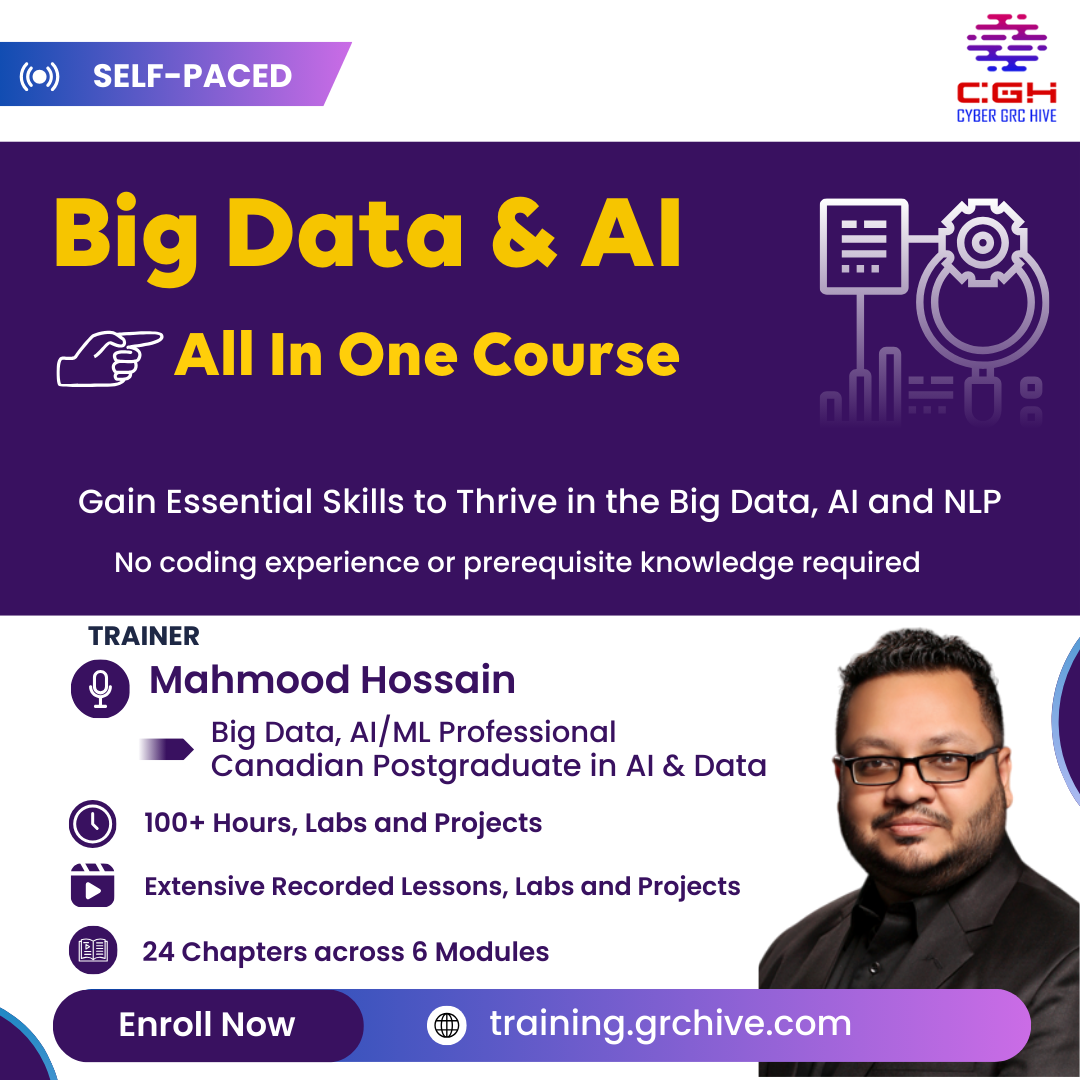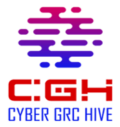Big Data & AI - All In One Course
Each Module blends theoretical lessons, hands‑on labs, and project work to ensure you not only learn the concepts but also implement scalable, production‑grade solutions.

Course Modules
Module 1: Foundations, Statistics, and Advanced Programming for Big Data
- Focus: Build a strong foundation in data fundamentals, Microsoft Excel, Python, statistics, data analysis, and distributed computing principles.
Chapter 0: Data Fundamentals and Microsoft Excel
Topics:
- Introduction to data types and structures (structured vs. unstructured data, databases, etc.).
- Basic data manipulation in Excel: sorting, filtering, pivot tables, and conditional formatting.
- Data visualization in Excel: charts, graphs, and dashboards.
- Formulas and functions in Excel for data analysis (SUM, AVERAGE, VLOOKUP, etc.).
Chapter 1–2: Advanced Python & Systems Programming
Topics:
- In-depth Python: advanced data structures, generators, decorators, concurrency (asyncio, multithreading, multiprocessing).
- Software engineering best practices: reproducible research, testing frameworks, version control, automation.
- Introduction to Python for Data Analysis: pandas, NumPy basics, and Jupyter notebooks.
Hands on
- Build modular codebases with unit testing and CI/CD pipelines.
- Create a data analysis script using pandas to clean and explore a dataset.
Chapter 3: Statistics and Data Analysis Fundamentals
Topics
- Descriptive statistics: mean, median, variance, standard deviation, and distributions.
- Inferential statistics: hypothesis testing, p-values, confidence intervals, and correlation analysis.
- Exploratory Data Analysis (EDA): identifying patterns, outliers, and relationships using Python.
Hands on
- Perform EDA on a dataset using pandas and seaborn for visualization.
- Conduct statistical tests (e.g., t-tests, chi-square) using scipy.stats.
Chapter 4: Distributed Data Processing & Cloud Fundamentals
Topics
- Hadoop and Spark architectures: RDDs vs. DataFrames, Spark optimization (partitioning, caching, serialization).
- Advanced SQL vs. NoSQL design patterns.
Hands on
- Optimize Spark jobs using tuning parameters.
Chapter 5: Advanced Database Platforms & Data Lakes
Topics
- Modern data warehousing with Snowflake.
- Building and managing data lakes: data quality, lineage, security.
Hands on
- Create and optimize ETL pipelines.
- Experiment with data lake architectures and real-time streaming analytics.
Module 2: Data Analysis and Visualization with Python and BI Tools
- Focus: Master data analysis with Python and business intelligence tools like Tableau, Power BI, Power Query, and DAX.
Chapter 6: Data Analysis with Python
Topics
- Advanced pandas: merging, grouping, pivoting, and time-series analysis.
- Data wrangling with NumPy and pandas: handling missing data, outliers, and data transformation.
- Visualization with matplotlib, seaborn, and plotly for interactive plots.
Hands on
- Build a comprehensive data analysis pipeline to process, analyze, and visualize a complex dataset.
- Create interactive dashboards using plotly.
Chapter 7: Business Intelligence with Tableau and Power BI
Topics
- Tableau: creating dashboards, calculated fields, and data storytelling.
- Power BI: data modeling, visualizations, and sharing reports.
- Power Query: data transformation and ETL processes in Power BI.
- DAX: writing measures and calculated columns for advanced analytics.
Chapter 8: Advanced Batch Processing & Spark Optimization
Topics
- Advanced PySpark: optimizing shuffle operations, broadcast variables, fault tolerance.
Hands on
- Process large datasets with Spark clusters and measure performance improvements.
Chapter 9: Cloud Data Engineering and Scalability
Topics
- Advanced features of Databricks and Snowflake: streaming and batch integration.
Hands on
- Deploy cloud-native ETL pipelines.
- Experiment with autoscaling and cost optimization.
Module 3: Deep Data Engineering and Real-Time Analytics
- Focus: Enhance skills in batch/stream processing, orchestration, and advanced cloud engineering.
Chapter 10: Real-Time Data Streams and Event Processing
Topics
- Apache Kafka and Flink for low-latency data processing.
- Architecting real-time pipelines with fault tolerance and scalability.
Hands on
- Build and deploy a real-time data streaming application.
- Integrate Kafka with Spark Streaming or Flink for IoT or social media data.
Chapter 11: Advanced Data Ingestion & Orchestration
Topics
- Apache NiFi for dynamic data ingestion.
- Orchestrating workflows with Airflow and Prefect: error handling, retries.
Hands on
- Design a robust pipeline to ingest, process, and validate data from multiple sources.
Module 4: Machine Learning, Deep Learning, and Advanced NLP
- Focus: Cover theoretical and practical aspects of ML, DL, and NLP with scalability focus.
Chapter 12: Machine Learning Fundamentals and Advanced Techniques
Topics
- Classical ML algorithms (regression, classification, clustering) with scalability.
- Hyperparameter tuning: grid, random, Bayesian optimization.
- Integrating statistical analysis for model evaluation (e.g., confusion matrix, ROC curves).
Hands on
- Develop and tune a fraud detection model using LightGBM and XGBoost.
- Visualize model performance metrics using seaborn and matplotlib.
Chapter 13: NLP Fundamentals and Preprocessing Deep Dive
Topics
- Advanced text preprocessing: tokenization, stemming, lemmatization, vectorization (TF-IDF, word embeddings).
- NLTK, spaCy, and Gensim libraries.
Hands on
- Build a sentiment analysis model using spaCy and pretrained embeddings.
- Experiment with data augmentation for text.
Chapter 14: Transformer Architectures and Advanced NLP Models
Topics
- Transformer models (BERT, GPT, T5): attention mechanisms, fine-tuning.
- Model interpretability and long-sequence dependencies.
Hands on
- Fine-tune a BERT model using Hugging Face Transformers.
- Build a text summarization or translation model.
Chapter 15: Introduction to MLOps for ML Projects
Topics
- MLOps fundamentals: model versioning, reproducibility, experiment tracking (MLflow).
- CI/CD pipelines for ML and containerization (Docker, Kubernetes).
Hands On
- Deploy a simple ML model using MLflow.
- Set up a Dockerized application with Kubernetes.
Module 5: Advanced AI, Generative Models, and MLOps Engineering
- Focus: Explore state-of-the-art AI, Generative AI, LLMOps, and production workflows.
Chapter 16: Generative AI and LangChain, LangGraph
Topics
- Generative models: VAEs, GANs, LLMs (GPT-4, Llama).
- LangChain for chaining and agent-based architectures.
- Agentic RAG and Agentic AI, MCP server, Agent2Agent, Large Context Models.
Hands on
- Build and deploy a document Q&A system.
- Experiment with generative approaches for content creation.
Chapter 17: LLMOps and Advanced Deployment Strategies
Topics
- Optimizing LLMs: quantization, pruning, scaling with Triton Inference Server.
- Retrieval-Augmented Generation (RAG) for NLP tasks.
Hands on
- Experiment with vector databases (e.g., Pinecone) for efficient retrieval.
Chapter 18: Advanced MLOps: Experiment Tracking and Continuous Integration
Topics
- CI/CD for ML: automated testing, deployment pipelines, versioning.
- Monitoring, logging, alerting with Prometheus, Grafana, MLflow.
Hands on
- Build a complete MLOps pipeline with experiment tracking and deployment.
Chapter 19: Integrative Capstone: From Prototype to Production
Projects
- Develop an end-to-end ML system for a real-world problem (e.g., recommendation system, predictive maintenance, NLP chatbot).
- Incorporate data visualization dashboards using Tableau or Power BI.
Deliverables
- Code repository, documentation, and presentation of system architecture.
Module 6: Advanced Data Engineering and Specialized NLP Applications
- Focus: Optimize pipelines and apply advanced NLP in specialized domains.
Chapter 20–21: Advanced Data Engineering Techniques
Topics
- Delta Lake and schema evolution in Databricks.
- Slowly Changing Dimensions (SCD) pipelines and data quality frameworks.
Hands on
- Deploy an SCD pipeline in Snowflake or Databricks.
- Integrate real-time ingestion with batch processing.
Chapter 22: Real-Time NLP Systems and Chatbots
Topics
- Streaming NLP with Kafka and Flink: real-time sentiment, topic analysis.
- Advanced chatbot architectures using transformers and context management.
Hands On
- Build and deploy a multilingual chatbot.
- Set up real-time streaming and monitoring for NLP outputs.
Chapter 23: Domain-Specific NLP and Ethical AI
Topics
- NLP for legal, medical, or financial text analysis.
- Bias, fairness, explainability in AI, and mitigation methods.
Hands On
- Build a domain-specific information extraction tool.
- Develop metrics for bias and fairness.
Chapter 24: Advanced AI Project Workshops
Activities
- Workshops on use cases (e.g., reinforcement learning for pricing, computer vision).
- Create visualizations for project results using Tableau or Power BI.
Deliverables
- Refined projects and performance analyses.
technical frameworks and Platforms that are Covered in the Course
Big Data & Distributed Processing
Hadoop: HDFS, MapReduce, YARN Apache Spark: RDDs, DataFrames, Spark SQL, PySpark Data Lake
Data Ingestion, Streaming & Orchestration
Apache Kafka Apache Flink Apache NiFi Apache Airflow
Data Analysis & Visualization
Python Libraries: pandas, NumPy, matplotlib, seaborn, plotly
BI Tools: Tableau, Power BI, Power Query, DAX
Statistics: scipy.stats, statsmodels
Microsoft Excel: data manipulation, formulas, pivot tables, charts
Machine Learning, Deep Learning & NLP
Scikit-learn, XGBoost, LightGBM
NLP: NLTK, spaCy, Gensim, Hugging Face Transformers
MLOps & DevOps
MLflow, Weights & Biases
Docker, Kubernetes
Terraform
FastAPI
Generative AI & LLMOps
LangChain
RAG
Agentic AI: MCP Protocol, Agent2Agent, Large Context Model
Boost Your Career with Big Data and AI Course
🌍 Online Batch – Secure Your Spot Now!
